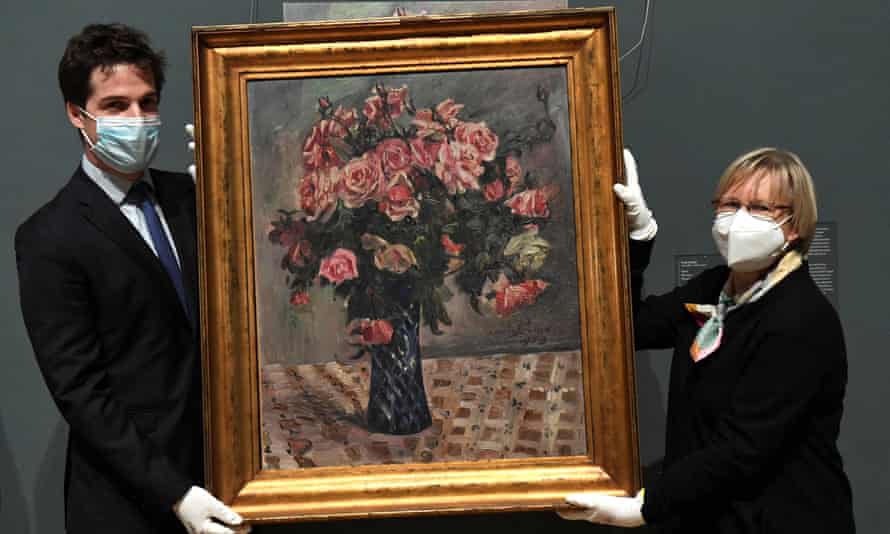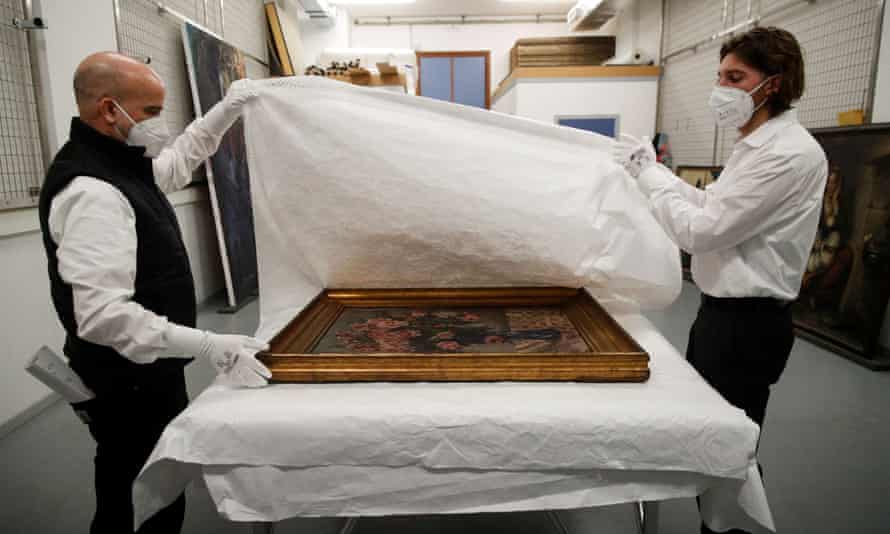Shared from Culture | The Guardian
Approximately 80 years after it was looted by the Nazis, an expressionist painting has been returned to the descendants of a German-Jewish couple by the Royal Museums of Fine Arts in Brussels.
Flowers, a 1913 still life by the German artist Lovis Corinth, was entrusted to the museums in 1951, because postwar investigators were unable to trace the original owners.
After years of research, the painting has been returned, the first restitution of any artwork looted from a Jewish family in the second world war by the Royal Museums of Fine Arts, which covers six museums, with works spanning the old masters to Magritte.
Thomas Dermine, Belgium’s secretary of state in charge of museums, handed the work to a lawyer representing the nine great-grandchildren of Gustav and Emma Mayer, a German-Jewish couple who fled Germany in 1938.
“This restitution, the first by the Museums of Fine Arts, is a very strong signal: even decades later, justice can triumph,” Dermine said. The return of the painting was also “an opportunity to remind people of the horrors” to which nationalism and the far right could lead, he said. “To repair is to remember and to remember is to avoid the return of the worst.”
The Mayers ran a successful business in Frankfurt before fleeing the Nazi persecution. They owned 30 paintings, which were left in storage in Brussels after a 14-month stay in the Belgian capital from 1938-39. Flowers is the only one to have been recovered.
Lawyers for the family approached the museums in 2016, eight years after it launched an online database about 27 works of uncertain provenance in the collections as part of an effort to find owners.
Imke Gielen, a lawyer with the Berlin firm Von Trott, who is acting for the Mayers’ descendants, said it was a historic day for the family. “They are delighted that at least one of the missing paintings has been identified after 80 years and has now been returned.”
The nine descendants, who live in the UK, South Africa and US, have yet to decide what to do with the painting, she said, adding: “Today is the day of restitution which we celebrate and other things will come in the next few days. The family has to decide.”
Gustav and Emma Mayer arrived in Brussels in June 1938, after fleeing through Italy and Switzerland. In August 1939, days before the outbreak of war, they made it to Britain and settled in Bournemouth.
Their eldest son, Ernst, was interned with other German-Jewish refugees as an “enemy alien” on the Isle of Mann. Gustav Mayer, in poor health when he left Germany, died in his mid-80s in 1940 of natural causes, although his death may have been hastened by the trauma of persecution and the difficult journey. His wife Emma died in 1944.

They never saw their paintings again. In 1942 a few works from the Mayer collection disappeared when the Nazi special taskforce led by Hitler’s acolyte, Alfred Rosenberg, began its work of plundering cultural treasures that belonged to European Jews.
By 1943 all the Mayer property in Brussels had been stolen. One highlight of the collection was a painting of a horseman on the beach by Max Liebermann, one of the leading impressionists in Germany. There were also other works by Corinth, as well as lesser-known Frankfurt artists.
Michel Draguet, the museum’s director, said he felt no sadness that the work would leave the museum, where it had been on display in the modern art collection.
“We never bought this painting, we were never the owners, we were the custodians for the Belgian state.” He and all his staff felt they were fulfilling the museum’s role in society, he said.
Draguet had scored out the painting from the museum’s inventory, a brown foolscap A4-sized book, with the word “register” printed in French and Dutch on the front.
The handover ceremony took place in a new exhibition room showing other works given to the museum in 1951, when Belgium’s postwar Economic Recovery Service, the body in charge of restitution of missing art, was disbanded. The owners of the original works, a mix of old masters and 19th-century landscapes, have either never been identified or there are questions about how they were acquired.
One work by the 17th-century Bavarian artist Hans Rottenhammer, Diana and Callisto, was bought by a curator employed by Hermann Göring in 1941 from a Brussels art collector. Nothing of the work’s ownership before 1941 is known, raising questions about a possible forced sale.
The Mayers’ descendants repaid the German government the “small compensation” award they had received in the 1970s for the loss of Flowers, Gielen, their lawyer, said.
Meanwhile, aided by researchers, the family continue to search for the 29 missing paintings, which are registered on the German government database, lostart.de.
For now, there are no leads. “We have no images; we have descriptions, not all of them are very detailed so unfortunately,” Gielen said. “None of the other works has been identified yet.”
Images and Article from Culture | The Guardian

